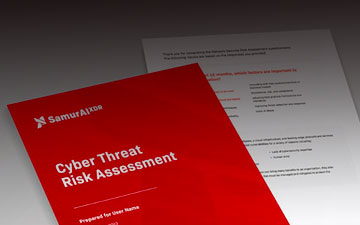Cybersecurity is a critical issue for businesses of all sizes. In order to protect your data, customers, staff, and reputation, you need to have a comprehensive security strategy in place.
Managed Detection and Response (MDR) services can help you improve your cybersecurity by identifying and responding to threats before they cause damage. A key component of MDR is “Threat Hunting”. You can think of threat hunting as detective work, performed by analysts, to discover threats that are hiding below the surface.
According to Norton, one cyberattack happens every 39 seconds. But MDR is a great solution for stopping threats — not only via automation, but thanks to automated analysis alerting, expert SOC security analysts then go on to review the threats. An important part of the work done by analysts is threat hunting.
In this blog post, we'll discuss how MDR threat hunting can help you protect your business from cyberattacks.
Why is threat hunting necessary?
Automation has changed the game when it comes to cybersecurity, but sophisticated threats can still sneak past an automated shield. While automated tools and analysts should be able to spot and block 80% of attacks, there’s a further 20% you need to respond to as well.
In the words of IBM:
"The remaining 20% of threats are more likely to include sophisticated threats that can cause significant damage. Given enough time and resources, they will break into any network and avoid detection for up to 280 days on average."
Effective threat hunting helps reduce the time between an attack taking place and that attack being identified. The faster your business can respond, the less damage cyber criminals can do.
What is the difference between threat hunting and threat intelligence?
Threat hunting
Threat hunting is a proactive approach to cybersecurity that involves looking for signs of an attack that have not been detected by automated security solutions.
This can be done by analyzing log files, network traffic, and other data sources.
Threat intelligence
Threat intelligence, on the other hand, is information that can be used to identify potential threats. It can come from a variety of sources, including open source intelligence, government agencies, specialist research bodies and proprietary intelligence.
Threat intelligence can be used to help plan and execute threat hunting efforts.
3 ways MDR threat hunting improves your cybersecurity
MDR applies threat intelligence and proactive threat hunting to identify and remediate advanced threats. MDR solutions can help reduce dwell time of attacks and deliver fast, decisive responses to attacks within the network.
This brings the following benefits:
Supplements preventive and detective controls
MDR solutions can supplement your existing preventive and detective controls. By proactively hunting for threats, MDR services can help you identify and respond to threats that would otherwise go undetected.
Reduces dwell time
MDR threat hunting can help reduce the amount of time an attacker has to do damage. In many cases, attackers will sit on a network for weeks or even months before they are detected. By identifying and responding to threats quickly, MDR services can help reduce the amount of time an attacker has to do damage.
Improves threat detection lifecycle
In order to be effective, threat hunting needs to be a continuous process. MDR services can help you improve your threat detection lifecycle by providing 24/7 monitoring and constant improvement of your security posture.
Evaluates and upgrades overall security posture
MDR services can also help you evaluate and upgrade your overall security posture. By constantly monitoring your network for threats, MDR services can help you identify areas where your security posture needs to be improved.
MDR Threat Hunting vs. SIEM
MDR services go beyond SIEM solutions by providing 24/7 monitoring, constant improvement of your security posture, and proactive threat hunting.
SIEM solutions are reactive, only alerting you after an incident has occurred. MDR services are proactive, helping you identify and respond to threats before they cause damage. While a SIEM collects data, it is how you use the data that makes the difference. This means, at a reactive level, you have to configure the SIEM correctly to alert you. With MDR, you don’t need to worry about working out how to interpret the data that is collected - skilled analysts who are using purpose-designed tools help you find the proverbial needle in a haystack.
In addition, analysts will perform hypothesis-based hunts, using advanced queries to analyze telemetry data for signs of threats which have evaded other methods of detection. This is different from other methods of cybersecurity, which only use automated systems.
For more information about how MDR works and how it compares to MSSP read this blog post.
Nothing gets past a Samurai
The insights gained from MDR threat hunting can help you improve your cybersecurity posture by pointing to areas where you can supplement your existing security controls, making it harder for attackers to penetrate your network in the future and reducing the amount of time they have to do damage if they do get in.
If you're looking for a way to improve your cybersecurity, MDR threat hunting is a great place to start.
Featured articles
Identity Management in the Physical and Digital Worlds
7 August 2024 | Webinars
In today's rapidly evolving world, managing identities securely and efficiently is more crucial than ever. Join us for an insightful...
Identity Management in the Physical and Digital Worlds
30 July 2024 | Webinars
In today's rapidly evolving world, managing identities securely and efficiently is more crucial than ever. Join us for an insightful...
XDR for Small and Medium Businesses: Is It Worth It?
24 July 2024 | XDR
Cybersecurity is of paramount importance to virtually all organizations and SMBs have to address several specific challenges. The failure to...





